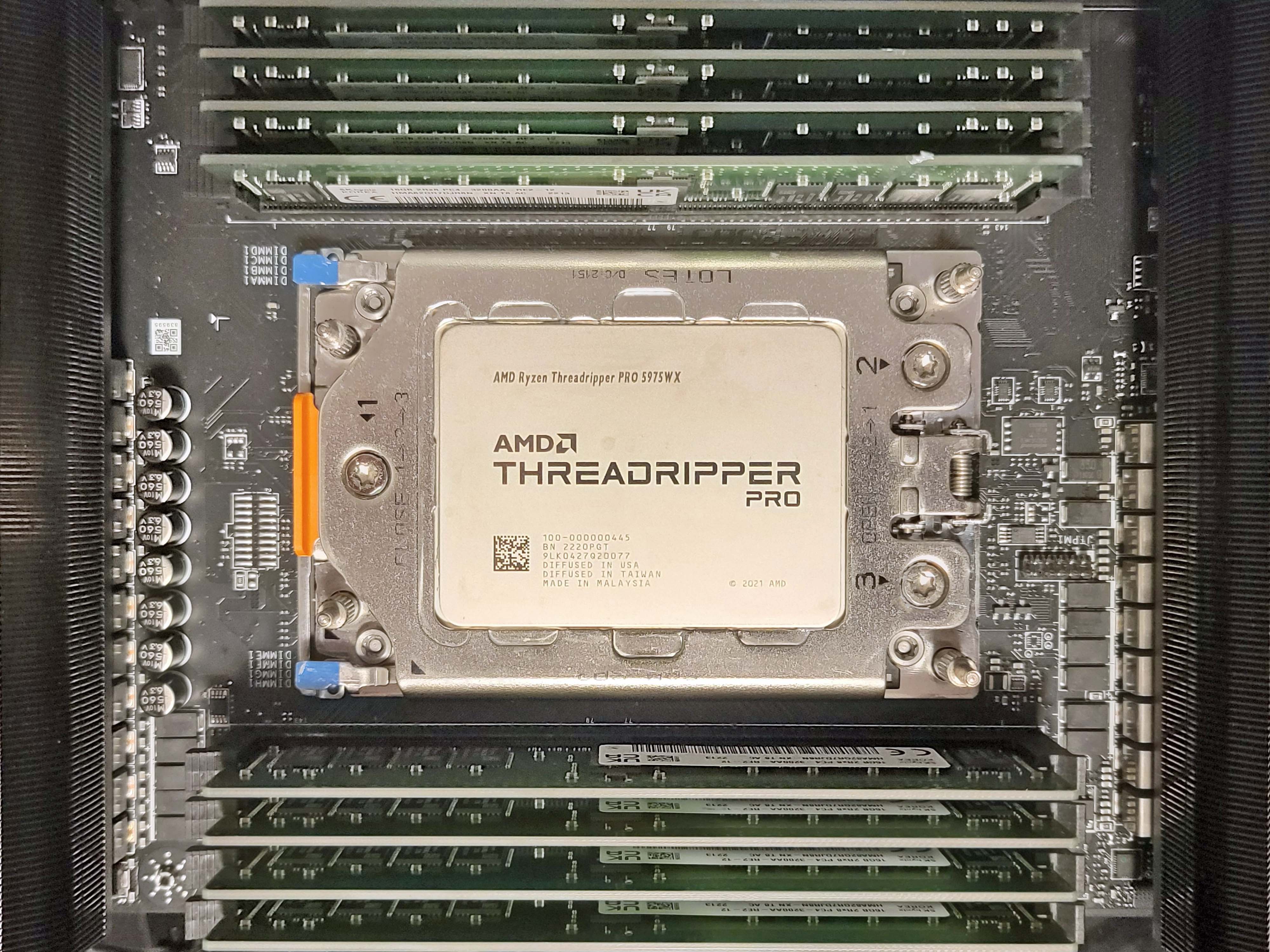Tom's Hardware Verdict
The Threadripper Pro 5995WX and 5975WX deliver simply unmatched performance and capabilities courtesy of industry-leading core counts and connectivity that easily outstrips all competitors.
Pros
- +
Unmatched performance in threaded work
- +
Competitive single-thread performance
- +
Industry-leading 128 lanes of PCIe 4.0
- +
Octo-channel memory
Cons
- -
Expensive chip pricing
- -
Expensive motherboard pricing
- -
Limited DIY motherboard options
Why you can trust Tom's Hardware
The new 64-core AMD Threadripper Pro 5995WX and 32-core Threadripper Pro 5975WX are finally available at retail, breaking free from the confines of pre-built OEM systems to contend for a spot on our list of best CPUs for workstations. They have a tough act to follow: AMD's previous-gen Threadripper CPUs delivered a crushing blow to the entrenched Intel's HEDT and workstation lineup, with the consumer models essentially muscling Team Blue out of the high end desktop (HEDT) market entirely while the Pro models relegated Intel to an also-ran in the workstation market.
But there's a problem for enthusiasts — Intel abandoned the consumer-oriented high end desktop (HEDT) market after its crushing defeat three years ago, and now that AMD is the only game in town for HEDT chips, it's also dropping the segment.
AMD says it will no longer make the more affordable non-Pro Threadripper models. Instead, we get the Threadripper Pro chips that are priced for professionals and come with all the trimmings to justify the price tag, like the Zen 3 architecture, clock speeds up to 4.5 GHz, 128 lanes of PCIe 4.0, and eight DDR4 memory channels that deliver unmatchable workstation performance.
AMD's original Threadripper chips (and supporting motherboards) were geared for HEDT, meaning they came with higher core counts and access to more memory and PCIe connectivity than mainstream desktop PC chips. However, pricing was still mostly within reach for enthusiasts. After several generations, AMD released its Threadripper Pro models with twice the number of memory channels (eight) for professional users and unique motherboards, but the beefy chips carried the eye-watering pricing to match their incredible performance.
AMD then maintained two lineups, one for consumers and one for professional workstations, but they had different pricing tiers even though they were based on the same underlying architecture. AMD changes that with the Threadripper 5000 WX-series, unifying the standard HEDT models with the professional lineup, meaning there's now only one line of chips and motherboards for both OEM workstations and DIYers — Threadripper Pro and the WRX80 platform.
| Row 0 - Cell 0 | Cores / Threads | MSRP/SEP | Base / Boost (GHz) | L3 Cache (MB) | TDP | PCIe |
| Threadripper Pro 5995WX | 64 / 128 | $6,499 | 2.7 / 4.5 | 256 (8CCD + I/OD) | 280W | 128 |
| Threadripper Pro 5975WX | 32 / 64 | $3,299 | 3.6 / 4.5 | 128 (4CCD + I/OD) | 280W | 128 |
| Threadripper Pro 5965WX | 24 / 48 | $2,399 | 3.8 / 4.5 | 128 (4CCD + I/OD) | 280W | 128 |
| Threadripper 5955WX | 16 / 32 | OEM-only | 4.0 / 4.5 | 64 | 280W | 128 |
| Threadripper Pro 5945WX | 12 / 24 | OEM-only | 4.1 / 4.5 | 64 | 280W | 128 |
The problem is AMD has left the two lower-end 12- and 16-core Pro models as OEM-only, so they won't come to retail. That means entry-level pricing for Threadripper Pro starts at $2,399 for a 24-core 5965WX — and that's before you purchase the requisite super-pricey motherboard (more below) and enough memory to fill eight channels. You'll pay $3,299 to step up to the 32-core Threadripper Pro 5975WX, and $6,499 for the 64-core 5995WX, both representing big markups over the prior-gen chips.
It does make some sense for AMD to keep the 12- and 16-core models as OEM only, given that Ryzen 5000 and the soon-to-be-launched Zen 4 Ryzen 7000 mainstream platforms already support up to 16 cores. However, those platforms don't have quad-or octo-channel memory or more than 20 PCIe lanes, a common reason for enthusiasts to step up to HEDT. Unlike the previous-gen Pro chips, all of the Threadripper Pro 5000 WX chips do support core and memory overclocking, though. That's a slight consolation prize, but only a few motherboards support the feature.
All of this means that AMD positions the Threadripper Pro chips squarely for the workstation market, and there they deliver. Like its predecessor, the 64-core Threadripper Pro 5995WX is a specialized beast that delivers unbeatable performance in workloads that can leverage parallelism. That said, some applications simply don't benefit from 64 cores, so you should know your workload before you pull the trigger. However, you won't find this many cores or PCIe lanes in a single-socket Intel workstation — the Intel Xeon W-3300 lineup is outclassed with its maximum of 38 cores and 64 PCIe lanes from a single chip. You'll have to pay a heart-stopping $6,499 for the retail 5995WX, though.
The $3,299 32-core Threadripper Pro 5975WX is the more rational choice for most professionals, again delivering stellar performance while offering all of the connectivity of its more expensive counterpart. This chip offers the lion's share of the 5995WX's performance and isn't as subject to finicky performance in some workloads.
We put both of these chips through a test suite of professional-class applications, like SPECworkstation and SPECviewperf, along with our standard application test suite. And yes, we put the chips through our gaming test suite to see how they fare.
Spoiler alert: They match AMD's fastest standard gaming chips.
Threadripper Pro 5995WX and 5975WX Specifications and Pricing
| Row 0 - Cell 0 | Cores / Threads | MSRP/SEP | Base / Boost (GHz) | L3 Cache (MB) | TDP | PCIe | Memory |
| Threadripper Pro 5995WX | 64 / 128 | $6,499 | 2.7 / 4.5 | 256 | 280W | 128 | Eight-Channel DDR4-3200 |
| Xeon W-3375 | 38 / 76 | $4,499 | 2.5 / 4.0 | 57 | 270W | 64 | Eight-Channel DDR4-3200 |
| Threadripper Pro 3995WX | 64 / 128 | $5,489 | 2.7 / 4.2 | 256 | 280W | 128 | Eight-Channel DDR4-3200 |
| Threadripper 3990X | 64 / 128 | $3,990 | 2.9 / 4.3 | 256 | 280W | 72 | Quad DDR4-3200 |
| Threadripper Pro 5975WX | 32 / 64 | $3,299 | 3.6 / 4.5 | 128 | 280W | 128 | Eight-Channel DDR4-3200 |
| Xeon W-3365 | 32 / 64 | $3,499 | 2.7 / 4.0 | 48 | 270W | 64 | Eight-Channel DDR4-3200 |
| Threadripper Pro 3975WX | 32 / 64 | $2,749 | 3.5 / 4.2 | 128 | 280W | 128 | Eight-Channel DDR4-3200 |
| Threadripper 3970X | 32 / 64 | $1,999 | 3.7 / 4.5 | 128 | 280W | 64 | Quad DDR4-3200 |
| Threadripper Pro 5965WX | 24 / 48 | $2,399 | 3.8 / 4.5 | 128 | 280W | 128 | Eight-Channel DDR4-3200 |
| Xeon W-3345 | 24 / 48 | $2,499 | 3.0 / 4.0 | 36 | 250W | 64 | Eight-Channel DDR4-3200 |
| Threadripper 3960X | 24 / 48 | $1,399 | 3.8 / 4.5 | 128 | 280W | 64 | Quad DDR4-3200 |
Threadripper Pro chips come with the 'WX' suffix to denote they are designed for the workstation market. AMD didn't introduce more cores with the two top-end models, but they're faster due to the step up from the Zen 2 architecture to Zen 3.
AMD has increased prices on the 64-core model by $1,000 and bumped up the 32-core chip by $550. All retail Threadripper Pro models have a top dual-core clock speed of 4.5 GHz, a generational increase of 300 MHz for the 5955WX and 5975WX. The 24-core 3975WX didn't have a previous-gen Pro counterpart, but its clock speeds are the same as the consumer 3960X. We also see a 100 MHz improvement to the base clock speed on all models except the 64-core, 128-thread Threadripper Pro 5995WX.
The Threadripper Pro chips have the same 280W TDP envelope as the previous-gen chips. Notably, the 280W limit is likely imposed by the sWRX80 socket design, so AMD doesn't have much room to increase frequencies for the highest-end part. As we've seen in previous tests, the core-heavy Threadripper models reach peak power consumption long before all of the cores are fully saturated, but the support for overclocking/PBO will help break those bonds.
Threadripper Pro has 128 PCIe 4.0 lanes (the CPU exposes 120 lanes to the user) compared to Intel's 64 lanes, an advantage because most workstations have plenty of additives, like GPU accelerators, NVMe storage, and high-speed NICs.
Except for the quad-channel Ryzen Threadripper 3000 chips, all of the above AMD and Intel processors support eight channels of DDR4-3200 ECC memory. Threadripper Pro supports a maximum of 2TB of memory in UDIMM, RDIMM, and LRDIMM flavors, while Xeon W-3300 supports up to 4TB. That's not to mention that AMD's core/thread counts weigh in at 64/128 compared to Intel's 38/76.
Get Tom's Hardware's best news and in-depth reviews, straight to your inbox.
As you can see, AMD slightly undercuts Intel's suggested pricing for the 24- and 32-core models, but the flagship 64-core 5995WX costs $2000 more than the highest-end 38-core Xeon W-3375.
The Threadripper Pro chips drop into single-socket WRX80 motherboards, so existing WRX80 motherboards support the 5000 series chips after a BIOS update. The LGA4094 socket (aka Socket sWRX8) is physically identical to the previous-gen Threadripper consumer and EPYC data center platforms, so coolers are also compatible. However, the socket features different pin assignments: AMD enabled some pins to support more memory channels and PCIe lanes than are available on the old Threadripper consumer chips and disabled certain pins used to support multiple sockets on EPYC platforms.
Here's how Threadripper has progressed over the years:
| Row 0 - Cell 0 | Codename | Year | Architecture | Socket | Chipset | Models |
| Ryzen Threadripper 1000 Series | Whitehaven | 2017 | Zen 1 | SP3r2 / TR4 | X399 | 1950X / 1920X / 1900X |
| Ryzen Threadripper 2000 Series | Colfax | 2018 | Zen+ | SP3r2 / TR4 | X399 | 2990WX / 2970WX / 2950X / 2920X |
| Ryzen Threadripper 3000 Series | Castle Peak | 2020 | Zen 2 | sTRX4 | TRX40 | 3990X / 3970X / 3960X |
| Ryzen Threadripper Pro 3000WX Series | Castle Peak WS | 2021 | Zen 2 | sWRX8 | WRX80 | 3995WX / 3975WX / 3955WX / 3945WX |
| Ryzen Threadripper Pro 5000WX Series | Chagall WS | 2022 | Zen 3 | sWRX8 | WRX80 | 5995WX / 5975WX / 5965WX / 5955WX / 5945WX |
AMD Threadripper WRX80 Motherboards
| Motherboard | Price |
| MSI WS WRX80 | Not Available |
| Supermicro M12SWA-TF | ~$700 |
| GIGABYTE WRX80 SU8 IPMI | ~$1,300 |
| GIGABYTE MC62-G41 | Not Available |
| ASUS Pro WS WRX80E-SAGE SE WIFI | ~$1,000 |
| ASRock WRX80 Creator | ~$900 |
It isn't all crimson and roses, though. The X399 platform was somewhat reasonably priced given its feature set, with most motherboards starting at around $350 (there was even a $240 model). Unfortunately, as you can see in the above table, we can't expect that kind of pricing with WRX80 motherboards — there's a limited number of WRX80 motherboards available to DIYers, and they start at $700. That isn't surprising given the copious slathering of cost-additive PCIe 4.0 lanes and the necessary retimers. WRX80 prices top out at $1,300, but two of the motherboards on AMD's list aren't available yet.
You'll also need to be careful with motherboard selection — many vendors designed their motherboards around the previous-gen Threadripper Pro family, which wasn't overclockable. As such, the Supermicro and ASUS WRX80 motherboards don't support overclocking. Given the relatively poor selection, high pricing, and general unavailability of many models, AMD and the motherboard makers have their work cut out for them to make this platform more accessible to DIYers.
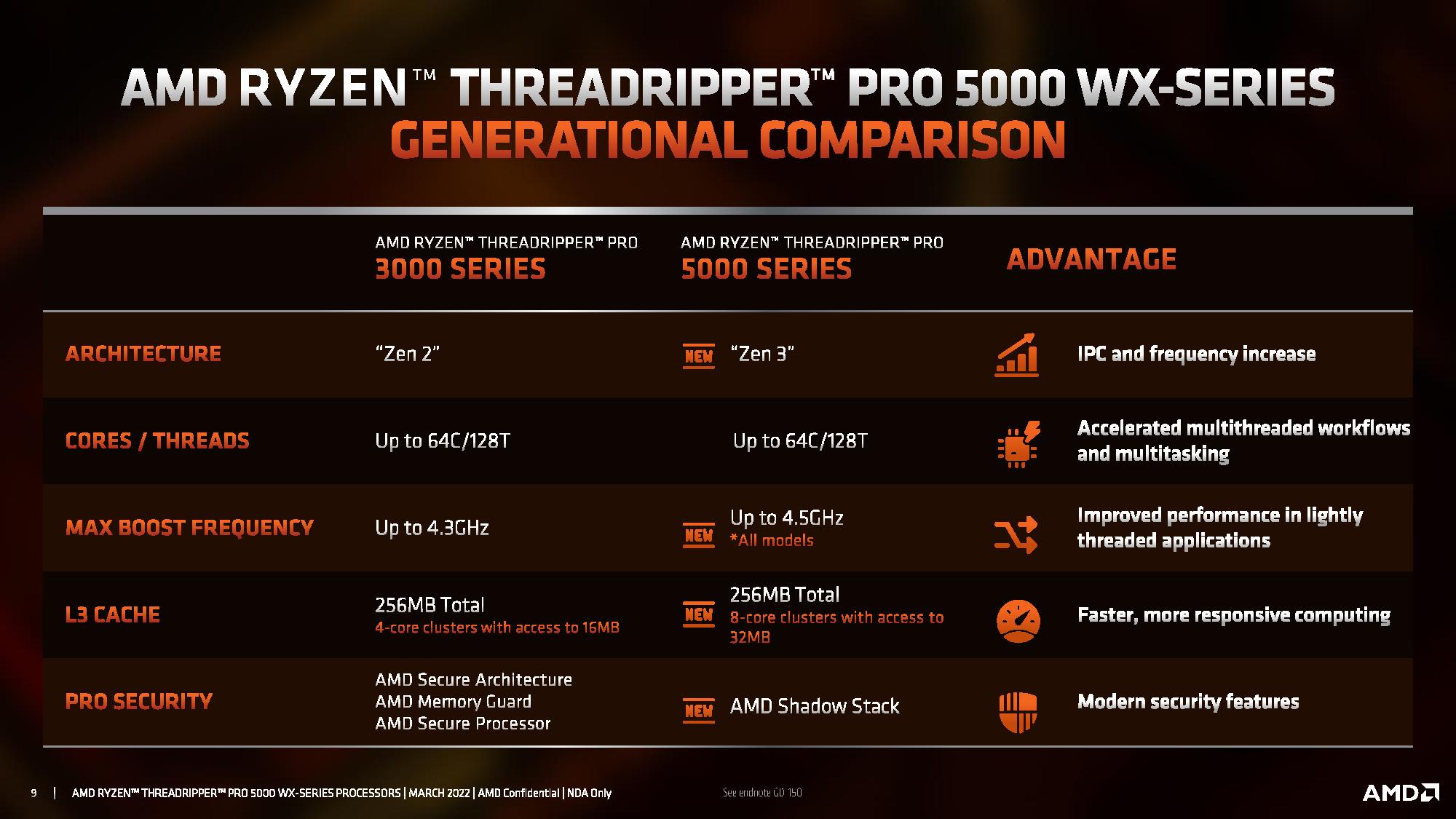
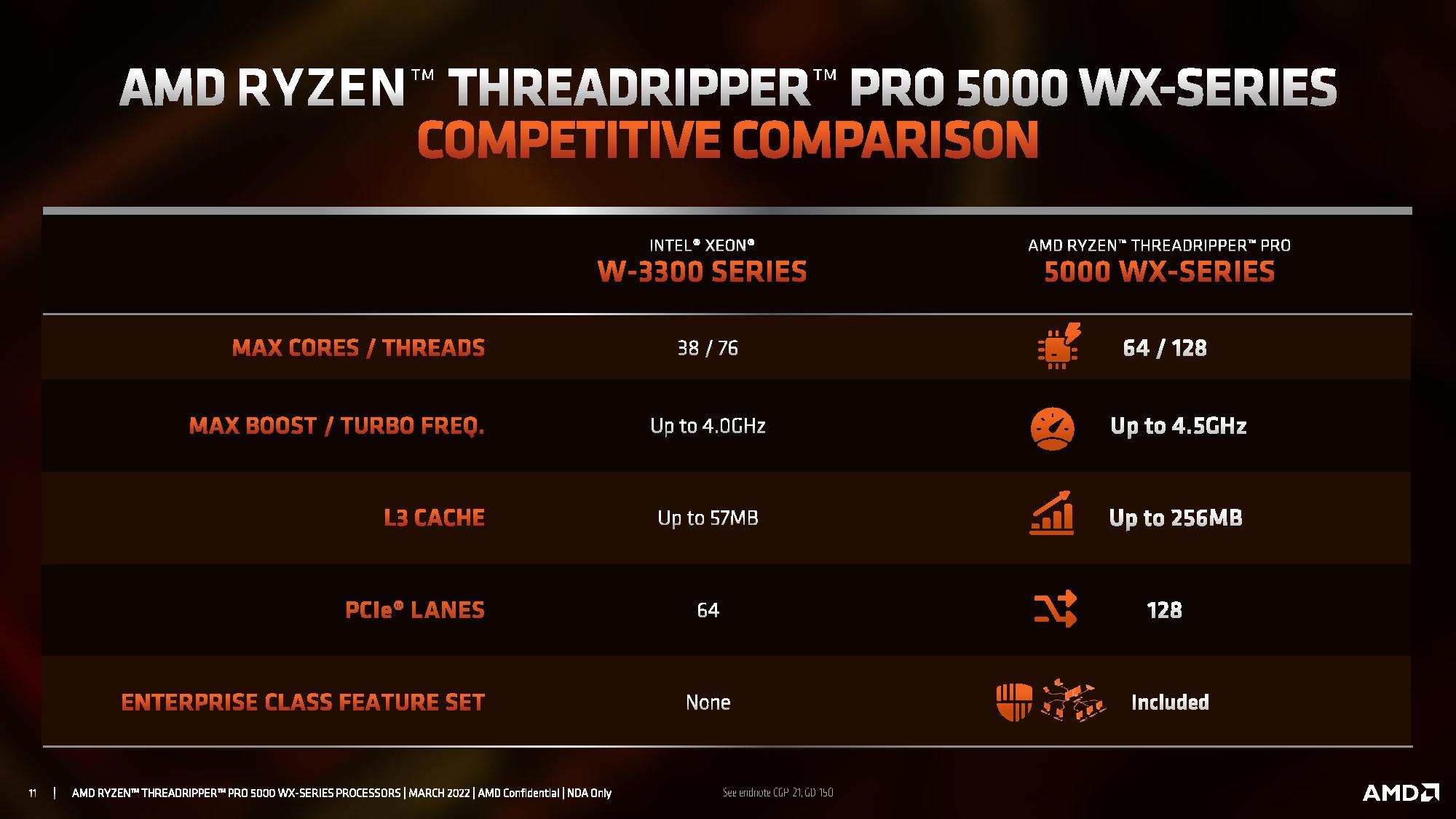
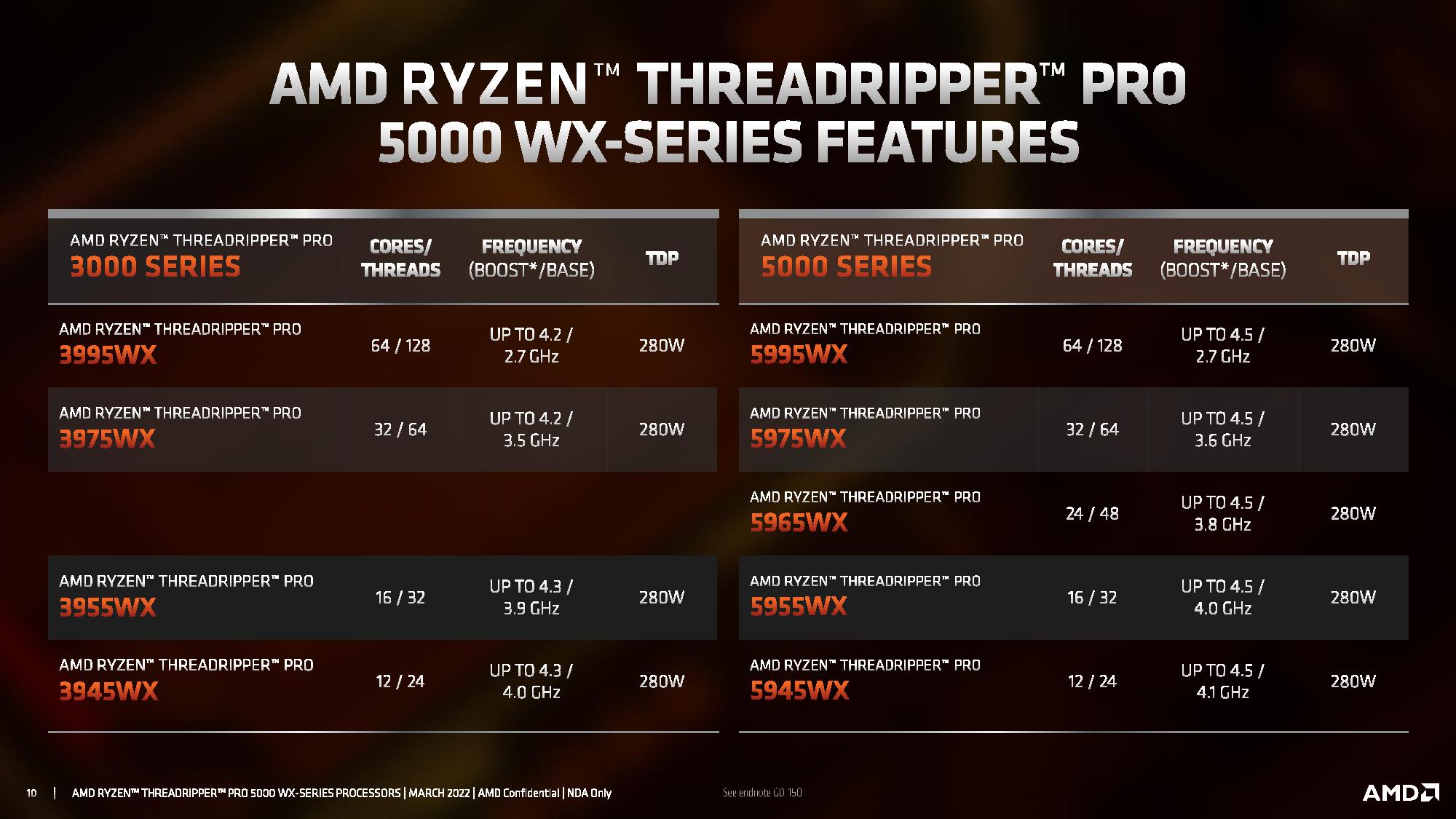

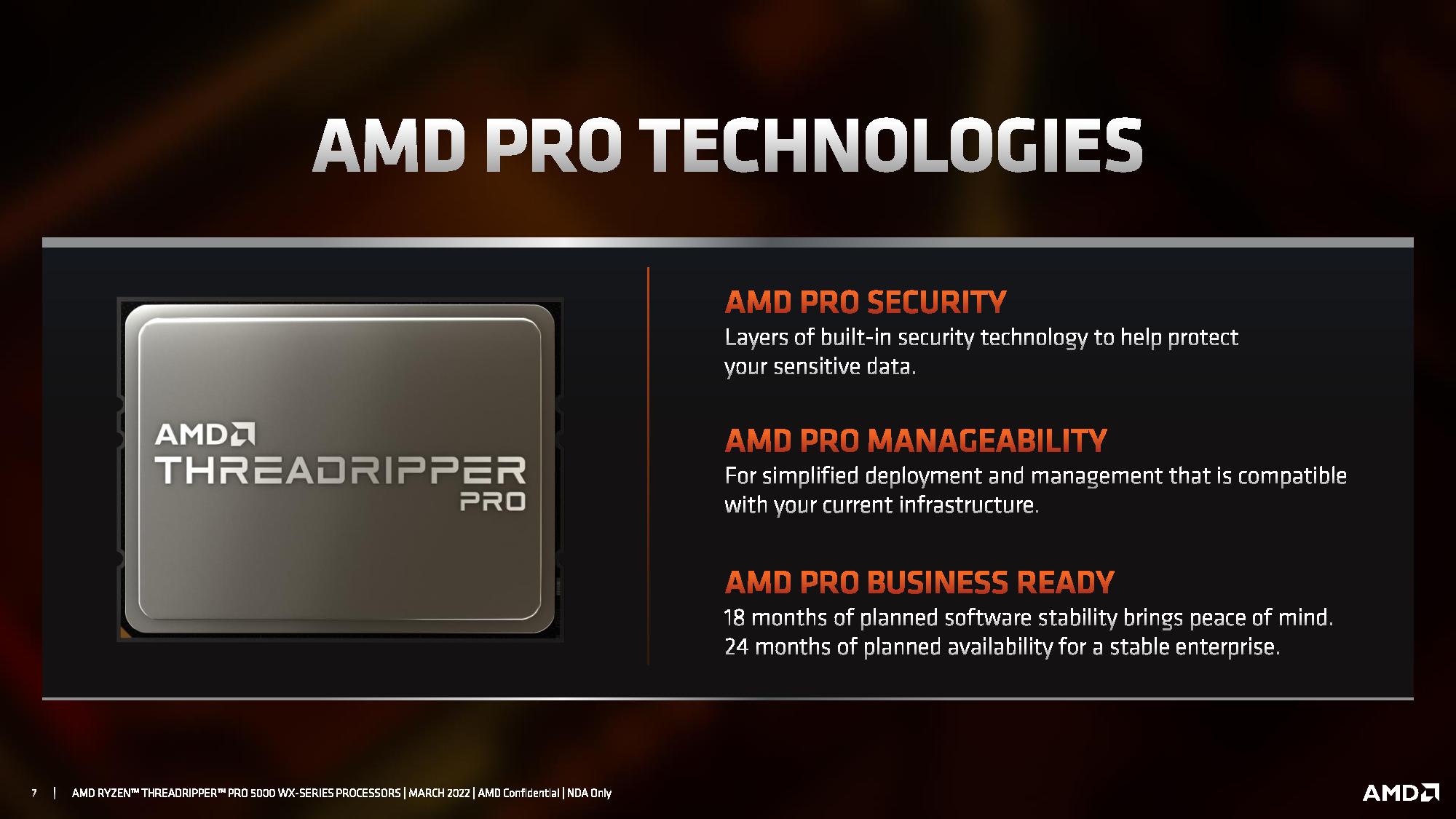
Threadripper Pro is based on a lightly-modified EPYC Milan design, so they move up from Zen 2 to the Zen 3 architecture. The Threadripper Pro chips still top out at an incredible 256MB of L3 cache on the highest-end models, but the cache is now a contiguous 32MB block for each eight-core cluster, improving performance over the prior gen. In contrast, Xeon W-3300 tops out at a paltry 57MB. The chips also bear all of the other benefits of Zen 3, like a 19% increase in instruction per cycle (IPC) throughput.
The chips support AMD's Pro Security, Manageability, and Business Ready suites (18-month software stability, 2-year chip availability), an area where Intel's competing chips are lacking. AMD's Pro Security suite includes the same Secure Architecture, Memory Guard (memory encryption with a slight performance penalty), and Secure Processor features as the prior-gen Threadripper Pro models, but AMD added Shadow Stack, a mechanism to counter control flow attacks. In contrast, Intel's Xeon W-3300 series doesn't have an enterprise-class feature set.
- MORE: AMD vs Intel
- MORE: Zen 4 Ryzen 7000 All We Know
- MORE: Raptor Lake All We Know
Current page: Unleash the Zen 3 Beast
Next Page Threadripper Pro 5995WX and 5975WX Power, Efficiency, Test Setup
Paul Alcorn is the Editor-in-Chief for Tom's Hardware US. He also writes news and reviews on CPUs, storage, and enterprise hardware.
-
-Fran- I love the latching mechanism of sWRX8. They should consider using it in consumer as well. I mean, they're already going to ask for a pretty penny on the current one, so why not just make the mechanism the best in the industry?Reply
And this looks quite impressive, specially since these can also do games quite well it seems. I wonder if AMD will ever put a "mini-Milan-X" in sWRX8 for whomever can pay for it? XD
Regards. -
escksu I am hoping tomshardware could test on win11 or server 2022. This is because these 2 OS by default will allow apps to use all available threadsReply
https://docs.microsoft.com/en-us/windows/win32/procthread/processor-groups -
Wisecracker Snagged an OEM ThinkStation P620 Workstation 16 or so months ago from RTP for $2,400 with ...AMD Ryzen TR Pro 3945WXReply
32GB DDR4-3200 RDIMM ECC
Quadro P2200 5GB - 4x DP_1.4
Marvell 10Gb Ethernet
512 GB M.2 Gen 3 PCIe SSDBuilt software RAID with 1TB Samsung SSDs, updated softwares (primarily Vegas Pro) with Canon SLR stuff and fancy appurtenances. Will do a minute -- in 30 seconds.
Other than a !%$@!*^ noisy PSU fan, it has been bulletproof ___ BUT, our good friends at AMD are taking advantage of their captured market. OEM prices easily are up 50% ... -
Sylwah Not a great article: this is a workstation processor and you're leading with gaming benchmarks, and continue to mostly cover gaming.Reply
Then there's the Windows 10/11 discussion.
Please do better next time. -
Guy Rouillier "The problem is AMD has left the two lower-end 12- and 16-core Pro models as OEM-only, so they won't come to retail."Reply
NewEgg has the Threadripper PRO 5955WX available now for $1299:
https://www.newegg.com/amd-ryzen-threadripper-pro-5955wx/p/N82E16819113776
That's a pretty hefty entry price for a home system, but it is available. The quad channel memory of the 3000 series was also better matched to the enthusiast market; only servers and high-end workstations benefit from the 8-channel memory. But I understand AMD's position; they are supply-constrained, so might as well go for the highest-priced markets available. -
This is not an option for home DIY builders, unless they have more money than senseReply
This is a workstation class processor and this is what we use at work on our workstations with tons of RAM and lots of storage so we can run as many virtual machines at once as we need for software development and testing
Threadrippers are all we use. we don’t bother with intel because they have NOTHING to touch it -
Guy Rouillier ReplyMandark said:This is not an option for home DIY builders, unless they have more money than sense
I wouldn't necessarily disagree with that, given the cost of a complete system on this platform. I was also a professional software developer, now retired. The last system I built for myself around 2013, which I'm still using, is a dual AMD Opteron 4234 with 16 GB of memory and all SSD storage. If I were to build a new system today, it would be with Threadripper. Though as I mentioned, for software development 8 memory channels is overkill; 4 really was the sweet spot. I ran our complete runtime environment on my system: a DBMS (Oracle or PostgreSQL), a web server with a JavaEE stack, a JBoss app server, plus all my development tools (Eclipse, etc.)
So, there is still a need for powerful workstation-class systems for individual end-users, but the numbers are small compared to the overall size of the market.
